Video of the Week:
Overwintering Geraniums
Upcoming Events:
December 1, 2 & 3, 2015
Kansas Expocentre, Topeka
For more information, go to http://www.kansasturfgrassfoundation.com/
Great Plains Growers Conference
January 7, 8 & 9, 2016
St. Joseph, MO
RetailWorks
February 4, 2016
Manhattan, KS
Vegetables:
Last Tomatoes of the Season
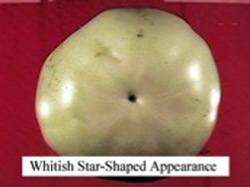
When harvesting fruit before a frost, separate tomatoes into three groups for storage: those that are mostly red, those that are just starting to turn, and those that are still green. Discard tomatoes with defects such as rots or breaks in the skin. Place the tomatoes on cardboard trays or cartons but use layers of newspaper to separate fruit if stacked. Occasionally a tomato may start to rot and leak juice. The newspaper will keep the juice from contacting nearby or underlying fruit. Store groups of tomatoes at as close to 55 degrees as possible until needed. (Ward Upham)
Peppers from the Garden
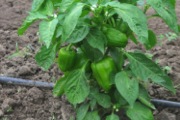
Fall Planting of Asparagus and Rhubarb
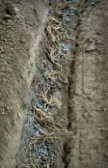
Prepare the soil and fertilize as you would in the spring. See http://www.bookstore.ksre.ksu.edu/pubs/mf319.pdf for more detail on asparagus and http://www.bookstore.ksre.ksu.edu/pubs/ep99.pdf for more information on rhubarb.
Water well after planting to insure good root/soil contact. Mulching would be helpful on the rhubarb to prevent the plant from heaving out of the soil during the winter but asparagus requires no such treatment as it is planted much deeper. (Ward Upham)
Turfgrass:
Frost on Lawns
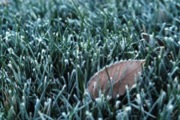
Should You let Turf Grow Tall in the Fall
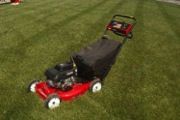
Turfgrass species vary genetically in their cold tolerance, with warm-season grasses being less cold tolerant than the cool-season types. Given these differences, cold tolerance is improved by increasing the health of the plants going into the winter, and healthy plants are a result of a sound management program (fertilizing, watering and mowing) during the spring, summer and fall. The lawn will benefit more from continuing to mow at the recommended height than from trying to gain some insulation against winter cold by allowing it to grow tall.
Here is a list of the recommended mowing height ranges (in inches) for home lawns in Kansas:
Tall fescue 2.5 -3.5
Kentucky bluegrass 2-3
Perennial ryegrass 2-3
Buffalograss 2-3
Bermudagrass 1-2
Zoysiagrass 1-2
(Note: Mowing at heights below 1.5 inches requires a reel mower). There may be some benefits gained by adjusting mowing heights WITHIN the recommended range at times. For example, it is a good practice to mow warm-season grasses at the higher end of recommended heights during late summer and early fall because this practice should help them store more carbohydrate reserves for the winter, and it may reduce the incidence of certain cool-weather diseases. But the rule to remember is to stay within the recommended height range for your species. (Ward Upham)
Ornamentals:
Fall Colors of Trees

Specific plant pigments determine individual colors. Foliage derives its normal green color from chlorophyll, the substance that captures the energy of the sun. Other pigments produce fall colors. Reds and purples are caused by anthocyanins, yellows by xanthophylls, and oranges by a combination of carotenes and xanthophylls. Browns are the result of tannins present in the leaf. Most of these substances are present throughout the growing season but are masked by the green color produced by chlorophyll. Anthocyanins are the exception and are produced after the chlorophyll is destroyed in the fall.
If you have ever seen pictures of New England in the fall, you have probably wondered why trees in Kansas usually do not color as well. This difference is partly because of the tree species prevalent in New England. Certain oaks and maples naturally produce good color. Coloring also is influenced by the weather.
Warm, sunny days and cool nights are ideal for good color. The sunny days encourage photosynthesis and, thus, sugar accumulation in the leaves. As fall progresses, each leaf develops an abscission layer at the base of the petiole, or leaf stem, that prevents these sugars from being transported down the trunk to the roots for storage. This high sugar content in the leaves produces more intense colors. Cloudy days and warm nights prevent some of the sugar accumulation in the leaves and results in less vibrant colors.
Weather during other parts of the growing season also can have an effect. Heavy rains in the early spring or hot, dry weather during the summer can both have a deleterious effect on fall color.
The length of time a tree maintains fall color also depends on weather. Reds, yellows and oranges are short-lived when trees undergo frosts and freezes. (Ward Upham)
Pests:
Oak Leaf Itch Mite

Unlike chiggers which have been long-recognized for producing annoying but fleeting bouts of itchiness, mysterious “bites” causing raised quarter-sized reddened areas each with a centralized pinhead-size blister were of widespread occurrence in 2004 in various Midwestern states.
Through investigative studies, the Pyemotes herfsi mites were identified as being responsible for the mysterious bites. Although the existence of these mites had been well known for multiple decades, the correlation between them and reported widespread occurrences of human discomfort was unknown. The severity of the 2004 outbreaks resulted in cooperative efforts between K-State and the University of Nebraska entomologists, the resultant being the identification of Pyemotes herfsi as responsible for the stressful skin disorders.
Pyemotes herfsi were recovered from marginal fold galls on (primarily) pin oak leaves. Marginal galls are associated with the larvae/maggots of tiny midges. That is, Pyemotes herfsi prey upon the midge larvae. The following side-by-side close-up images show an intact marginal gall, and a dissected gall revealing female Pyemotes herfsi. Despite their small size, they become readily visible due to their bulbous abdomens which can contain up to 200 offspring.
Due to their minuscule size compared to that of midge larvae, Pyemotes herfsi possess a potent neurotoxin used to paralyze their maggot hosts. This toxin is that which is responsible for initiating the skin irritations which cause discomfort in individuals upon which Pyemotes herfsi happens to come in contact with. Because Pyemotes herfsi are associated with the midge larvae responsible for marginal galls on oak leaves, Pyemotes herfsi have been given the common name, Oak Leaf Itch Mite. It is believed that oak leaf itch mites also prey upon the larvae of another closely related midge species responsible for the formation of vein pocket galls on the undersides of oak leaves. A full description of the oak leaf itch mite life cycle is available online by accessing Kansas State University Extension Publication MF2806.
The good news is that oak leaf itch mite populations may be extremely low or absent for years-on-end ------ people can enjoy the outdoors without having to contend with oak leaf itch mite encounters. The bad news is that the reappearance/resurgence of oak leaf itch mite populations is unpredictable.
More bad news: Each female oak leaf itch mite produces many progeny. And the developmental cycle is reported to be just 7 days. The resultant is the production of uncountable numbers of oak leaf itch mites which ultimately leave the confines of leaf galls. Passive dispersal via air currents is the bane to people, especially those in neighborhoods where pin oaks constitute the main trees species.
The bad news continues: There is a wide time frame during which encounters with oak leaf itch mite might occur. It is not only the initial late summer encounters, but the presence of oak leaf itch mites extending well into the fall when people are raking leaves and kids having fun playing in leaf piles. And if this is not enough negativity regarding oak leaf itch mites, there is little to be done (well, actually nothing to be done) in treating and reducing/eliminating their populations.
The people who are most likely to encounter oak leaf itch mites will be those in living in areas/neighborhoods where oaks (again, especially pin oaks) are the dominant tree species. When oak leaf itch mite populations are excessive, restricting outdoor activities is one method of reducing the risk of exposure. While the use of repellents may work against annoying insect species which actively seek a host, repellents have little effect against oak leaf itch mites which are passively dispersed, and lack the ability to alter their course/direction. It has been suggested that susceptible individuals (yes, some people do not have negative reactions to oak leaf itch mite bites) spend as little outdoor time as possible. And showers immediately upon returning indoors might eliminate/wash off mites before they bite and cause reactions.
Individuals experiencing oak leaf itch mite encounters might utilize medications and lotions so designed to provide relief from itching discomfort as well as secondary infections of excoriated areas. Seek advice and recommendations from appropriate personnel. (Bob Bauernfeind)
Contributors: Bob Bauernfeind, Entomology; Ward Upham, Extension Associate
December 1, 2 & 3, 2015
Kansas Expocentre, Topeka
For more information, go to http://www.kansasturfgrassfoundation.com/
Great Plains Growers Conference
January 7, 8 & 9, 2016
St. Joseph, MO
RetailWorks
February 4, 2016
Manhattan, KS
 RSS Feed
RSS Feed
